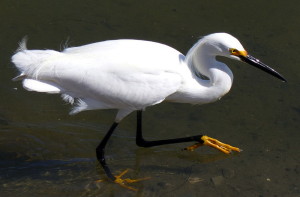Egret feathers were worth more than gold in the late 1800s, when the fashion industry used them to decorate women’s hats. These spectacular birds were nearly hunted to extinction—and might well have disappeared if not for Boston socialites Harriet Lawrence Hemenway and her cousin Minna Hall, who rallied 900 women to boycott feathered hats in the late 1890s.
Their activism eventually led to the creation of the National Audubon Society and laws including the Migratory Bird Treaty of 1918, which made it illegal to kill, sell, or own wild birds.
I feel grateful to these women as I watch five great egrets stalk fish in a salt marsh at a place named for another heroine—the Rachel Carson National Wildlife Refuge. Established in 1966, the refuge protects estuaries and salt marshes for migratory birds, as does the neighboring Wells National Estuarine Research Reserve.
Today, great egrets and snowy egrets grace estuaries from Maine to Texas at various times of year. How do you tell them apart? Great egrets are bigger—39 inches tall, have long slender yellow beaks and black legs and feet. Snowy egrets are smaller—24 inches tall, with long black beaks, black legs and yellow feet. (You can tell great egrets from great white herons because the latter have buff-gray legs and a heavier bill).
Look for both egrets in northern estuaries in summer and year-round in the south. It is always a treat to come upon these dazzling birds, whom Mary Oliver described as “a shower of white fire” in her poem Egrets.
Egrets are among nearly 60 animals featured in The Secret Bay, a new picture book by Kimberly Ridley and illustrated by Rebekah Raye, the award winning author and illustrator of The Secret Pool. (Tilbury House Publishers)

